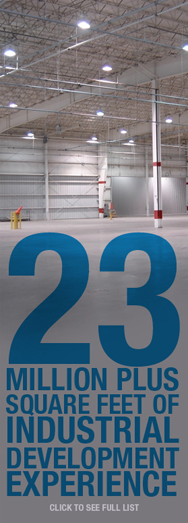Forecasted Increase for Industrial Space Demand from NAIOP
According to the data:
* The current annualized rate of growth (4Q2010) is 1.24 percent, which is in line with the historical average of 1 to 2 percent.
* Prior to 3Q2010, industrial space demand had been in “contraction mode” marked by seven consecutive quarters of negative demand for industrial space. In 4Q09, demand declined at an average annualized rate of 1.2 percent, which was below the rate of decline in the prior quarters of 2009.
* The two main variables used in the calculation – Purchasing Manager Index and Index of Manufacturing Output (see below for details) – are strong and suggest positive increases in demand during the next several quarters.
* Two of the demand drivers (PMI-Employment and PMI-Inventory) are currently ranging from average to strong however; they are trending down from previous quarters, suggesting the industrial market is unlikely to expand exceptionally until the overall economy becomes more robust.
* The remaining demand drivers (PMI-New Orders, PMI-Production and PMI-Deliveries) are currently ranging from average to strong and are trending up, which suggest an increasing demand for industrial space.
* The outlook for demand of industrial space is similar to the overall outlook for the economy – in that markets are stabilizing and beginning the process recovery. However, in the early phase of a recovery period, markets remain sensitive to exogenous shocks and events.
* Therefore, demand for industrial space in 1Q2011 is projected to grow at a 1.70 percent annualized rate, which is on par with historical averages suggesting that the sector is improving.
The demand for industrial space in 1Q2011 is projected to grow at a 1.70 percent annualized rate, which is on par with historical averages suggesting that the sector is improving, according to the Industrial Space Demand Forecast, a new study and model funded by the NAIOP Research Foundation that predicts future demand for industrial real estate by analyzing various economic factors and net absorption data.
“The upward trend demonstrates renewed confidence and increased activity in the industrial market, and the data provides valuable information for the developers and financiers to make better transaction decisions,” said Thomas J. Bisacquino, NAIOP president and CEO.
Prior to 3Q2010, industrial space demand had been in “contraction mode” marked by seven consecutive quarters of negative demand for industrial space. In 4Q09, demand declined at an average annualized rate of 1.2 percent, which was below the rate of decline in the prior quarters of 2009.
The two main variables used in the calculation – Purchasing Manager Index and Index of Manufacturing Output – are strong and suggest positive increases in demand during the next several quarters. Overall, the outlook for demand of industrial space is similar to the overall outlook for the economy – markets are stabilizing and beginning the process recovery. However, in the early phase of a recovery period, markets remain sensitive to exogenous shocks and events.
The report was co-authored by Dr. Randy Anderson, University of Central Florida, and Dr. Hany Guirguis, Manhattan College. Learn more about this resourceful forecasting tool by reading the full report and view the accompanying graphics at NAIOP’s Research Foundation Web site.

